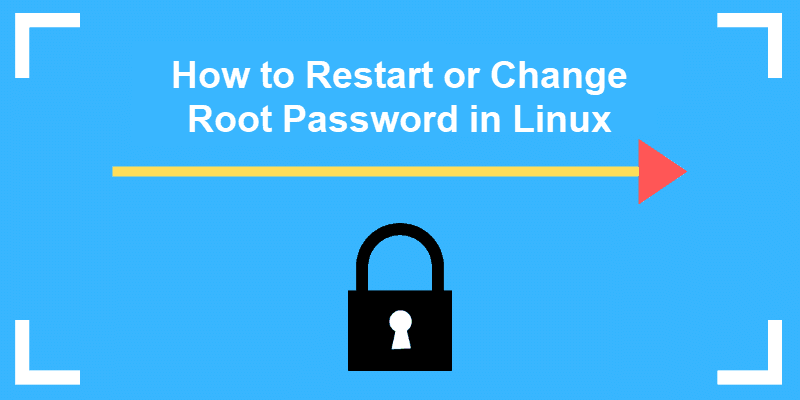how to change root password in centos 7
Introduction
In Linux, root privileges (or root access) refers to a user account that has full access to all files, applications, and system functions.
Almost basic Linux user accounts run with express privileges. This keeps users from making mistakes or accidentally exposing the arrangement to vulnerabilities.
To use protected operating system features, a Linux user has to temporarily elevate their privileges using a control like sudo . The sudo command tells the arrangement to run a command as a superuser, or root user. When you run a function using sudo , you'll ordinarily have to enter your password.
Some versions of Linux will drag your user privileges for a set amount of time around (xv minutes) earlier reverting. Other versions only perform a single job with elevated privileges.
Information technology'south a good idea to change your passwords regularly and consider using enterprise password management software.
This guide volition help you change your Linux root password in Ubuntu or CentOS, or reset the countersign.

Prerequisites
- A calculator running Linux
- Control-line interface (concluding)
Irresolute Your Root Countersign in Ubuntu
Stride 1: Open a Terminal Window
Right-click the desktop, then left-click Open in final.
Alternately, yous tin click Card > Applications > Accessories > Terminal.
Step 2: Alter Your Root Countersign
In the terminal window, type the following:
sudo passwd root The system will prompt you to enter your password – this is the same password you utilize to log in to the system.
Next, the system will prompt you to enter a new countersign. Exercise and so, and and then re-enter information technology exactly the aforementioned when the system prompts y'all to retype the password. This double-entry confirms that you have typed the countersign correctly.

Resetting a Root Password in Ubuntu
In some situations, you may need to admission an account for which yous've lost or forgotten a countersign.
Stride 1: Boot to Recovery Mode
Restart your organisation. Once yous see the splash screen for the computer manufacturer, agree downward the shiftfundamental. The organisation should come upwardly with a black and white Chow, or boot bill of fare, with different Linux kernel versions displayed.
Select the 2d one from the tiptop – the highest revision, followed by (recovery mode). Press Enter.
Step 2: Drop Out to Root Shell
The organisation should display a bill of fare with different kick options. Use the arrow keys to navigate to the pick labeled rootand press Enter.
The arrangement should respond by giving you lot a control-line interface with a prompt.
Step iii: Remount the File System with Write-Permissions
Correct now, your system only has read-merely access to your system. That means it can look at the data, but cannot make whatsoever changes. But we need write-access to change the password, so we'll demand to remount the bulldoze with the appropriate permissions.
At the prompt, blazon:
mount –o rw,remount / Press Enter. This should allow y'all to make changes to the data on the difficult drive.
Pace 4: Change the Password
At the prompt, type:
passwd username Substitute the proper noun of the user for username, then press Enter. The system asks you lot to type a new UNIX password and then to retype it.
In one case y'all've entered and confirmed the new password, reboot the organisation past entering the following:
shutdown –r Hit Enter, and your system should restart. Don't press any keys, let the system come up to the login screen, and test to make sure the new password works.
Irresolute the Root Countersign in CentOS
Changing a password in CentOS is almost identical to irresolute it in Ubuntu.
Step 1: Access the Control Line (Terminal)
Right-click the desktop, then left-click Open in Concluding. Or, click Menu > Applications > Utilities > Terminal.
Stride 2: Alter the Password
At the prompt, type the post-obit, and so press Enter:
sudo passwd root The system should prompt you lot to enter your existing password. Do then, then follow the prompts to enter and confirm a new root password.

Reset Root Countersign in CentOS
This is a similar process as in Ubuntu, with a couple of variations.
Step ane: Access Boot Carte du jour
Restart the system, then tap the Escfundamental nearly one time per 2nd to launch the Chow menu.
Footstep 2: Edit Kick Options
Employ the arrows to highlight the version of Linux yous boot into, then printing e.
Use the arrows to highlight the line that starts with kernelor Linux.
Printing East.
At the terminate of the line, add together a space then type unmarried. Press Enter, then kicking into single-user way by pressing Ctrl-10 or B. (The system volition brandish the control to use.)
Step 3: Remount the Drive
You should have a command line, and you'll have root privileges. To enable read/write access on your hard bulldoze, type the post-obit:
mountain / -o remount,rw Step 4: Changing the Password
Type the post-obit:
passwd Printing Enter, and the system should prompt you lot to enter and ostend a new password.
Footstep 5: Restart
Type the following, pressing enter after each line:
mount / -o remount,ro sync reboot Your system should restart. Confirm that your new countersign works by logging in.
Notation: If you e'er come up beyond a Linux boot failure, be sure to salve our guide on using GRUB rescue to troubleshoot it.
Determination
If you lot already have admission to your user account, resetting or changing your password in Linux is simple.
It can be more challenging if you lot've lost or forgotten a password, but with a little artistic restarting and editing, you shouldn't observe it too hard.
Was this article helpful?
Yes No
Source: https://phoenixnap.com/kb/how-to-change-root-password-linux
Posted by: georgewrond1958.blogspot.com


0 Response to "how to change root password in centos 7"
Post a Comment